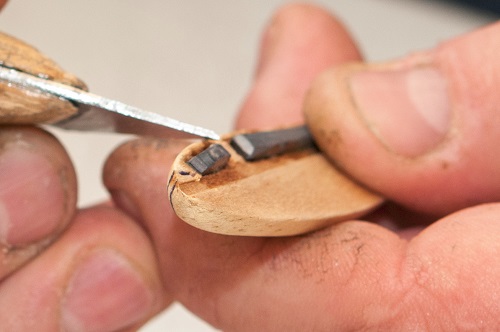 Bagley Bait Companies long tradition of innovation, paired with a 60 year legacy of creating some of the worlds most coveted and legendary lure models, continues with the introduction of the HCM manufacturing process. The HCM Process – Heat Compression Molding – is a significant step forward in the world of balsa wood manufacturing. As an alternative to the traditional balsa carving and “drill and fill” processes still
Bagley Bait Companies long tradition of innovation, paired with a 60 year legacy of creating some of the worlds most coveted and legendary lure models, continues with the introduction of the HCM manufacturing process. The HCM Process – Heat Compression Molding – is a significant step forward in the world of balsa wood manufacturing. As an alternative to the traditional balsa carving and “drill and fill” processes still
practiced today by current balsa makers, the HCM Process results in a finished product that is superior in consistency and function. The process ensures that each lure is precisely weighted and balanced so that it achieves the subtle action and attributes expertly designed into a specific lure model – each and every time.
Stage One
Balsa wood has been used by Bagley since the early 60’s. It is a superior material for replicating the swimming actions of bait fish and has long been a staple of many leading manufactures. The HCM process begins in a similar manner as the Traditional Manufacturing Process. Balsa is imported into the factory and hand sorted for densities. Then the balsa lengths are then placed into a lath and a particular lure model body is roughly carved into its approximate shape. The process similarities now end here.
Stage Two
In the HCM process, the balsa chunk is now sectioned in half, lengthwise. The balsa halves are placed into a heated metal mold and then compressed together to form the mirror left and right halves of a particular lure model. The heated molds cause the balsa form to shrink and to also slightly singe the wood which creates a much harder balsa exterior. (The balsa emerges in a darker charred form from the molds.) This compression process provides for truer consistency in lure weight and in an extremely smooth surface. The heat process has tightened the balsa wood grain which results in fewer coats of paint and primer needed in the final finish stages.
In addition to the heat molding forming the lure exterior, the process also forms specific internal channels and weight chambers that are in precise placement within the lure bodies inside halves. These formed chambers allow for the exact placement of internal hardware so that the lure can meet the specific model action requirements of the designer.

Stage Three
The balsa halves are removed from the molds and then the hardware and weight systems are then inserted into the internal chambers. This step also includes a full wire through harness on these balsa designs – allowing for maximum strength when there is a fish on.
Stage Four
The balsa halves are joined and sealed together. A small amount of filler is then applied to the seams and then hand sanded for a completely smooth exterior finish.
Stage Five
Each model is then lipped, primed, and painted through a combination of pad and overspray techniques. Each lure is then hooked and sent on to be tanked tested. The tank testing step now used is only to ensure that the lip and nose ring are properly aligned. The HCM process eliminates the need to test each lure for other traditional manufacturing processing defects.
The HCM process allows for 100% consistency of design – in terms of size, shape and function. It creates unlimited design opportunities by freeing the lure designer to precisely position internal weighting for optimal balance points – something not achievable in the traditional manufacturing processes.
The HCM Process is another milestone from the people at Bagley. By re-thinking how we manufacture with balsa, we simply are challenging ourselves to make better lures that catch fish day in and day out. Who said you can’t build a better mousetrap?
Link – https://bagleybait.com/the-hcm-process/
